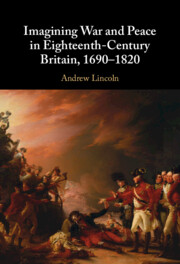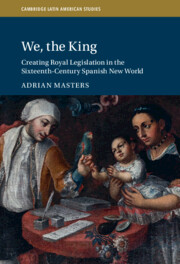57 results
Chapter 8 - locum tua tempora poscunt
-
-
- Book:
- The Augustan Space
- Print publication:
- 27 June 2024, pp 126-145
-
- Chapter
- Export citation
Chapter 1 - 1536: The Creation of a Literary Space
- from Part I - Literary Dates
-
-
- Book:
- A History of Argentine Literature
- Published online:
- 09 May 2024
- Print publication:
- 16 May 2024, pp 11-23
-
- Chapter
- Export citation
1 - Plural Beginnings
-
- Book:
- Sharing Freedom
- Published online:
- 28 March 2024
- Print publication:
- 04 April 2024, pp 31-74
-
- Chapter
- Export citation
1 - Prelude: The Mughal Empire, 1526–1750
-
- Book:
- Bankrolling Empire
- Published online:
- 16 November 2023
- Print publication:
- 30 November 2023, pp 43-70
-
- Chapter
- Export citation
Chapter 11 - A Case Study
- from Part IV - The Landscape of Conquest
-
- Book:
- Imagining War and Peace in Eighteenth-Century Britain, 1690–1820
- Published online:
- 10 January 2024
- Print publication:
- 23 November 2023, pp 261-280
-
- Chapter
- Export citation

Imagining War and Peace in Eighteenth-Century Britain, 1690–1820
-
- Published online:
- 10 January 2024
- Print publication:
- 23 November 2023
Chapter 4 - Sacrifice
- from Part I - Developing Ideals
-
- Book:
- Imagining War and Peace in Eighteenth-Century Britain, 1690–1820
- Published online:
- 10 January 2024
- Print publication:
- 23 November 2023, pp 100-120
-
- Chapter
- Export citation
14 - The Cycle of Inevitability in Imperial and Republican Identities in China
- from Part ii - Paradigm Shifts and Turning Points in the Era of Globalization, 1500 to the Present
-
-
- Book:
- The Cambridge History of Nationhood and Nationalism
- Published online:
- 27 October 2023
- Print publication:
- 09 November 2023, pp 301-328
-
- Chapter
- Export citation
1 - The Discoverer
-
- Book:
- Being the Heart of the World
- Published online:
- 28 September 2023
- Print publication:
- 12 October 2023, pp 24-62
-
- Chapter
- Export citation
1 - How Supply Shocks Arise and Why Political Responses to Them Vary
-
- Book:
- Shocking Contrasts
- Published online:
- 09 June 2023
- Print publication:
- 17 August 2023, pp 9-27
-
- Chapter
- Export citation
Introduction
-
- Book:
- Middle Imperial China, 900–1350
- Published online:
- 20 July 2023
- Print publication:
- 03 August 2023, pp 1-13
-
- Chapter
- Export citation
2 - The Theology of Victory of the Slaughtered Lamb
-
- Book:
- Royal Ideologies in the Book of Revelation
- Published online:
- 22 June 2023
- Print publication:
- 06 July 2023, pp 52-81
-
- Chapter
- Export citation
2 - The Theology of Victory of the Slaughtered Lamb
-
- Book:
- Royal Ideologies in the Book of Revelation
- Published online:
- 22 June 2023
- Print publication:
- 06 July 2023, pp 52-81
-
- Chapter
- Export citation
3 - By Force It Was Destroyed
-
- Book:
- Nothing More than Freedom
- Published online:
- 04 May 2023
- Print publication:
- 11 May 2023, pp 73-111
-
- Chapter
- Export citation
7 - Extirpation and Annihilation in Cromwellian Ireland
- from Part II - Empire-Building and State Domination
-
-
- Book:
- The Cambridge World History of Genocide
- Published online:
- 23 June 2023
- Print publication:
- 04 May 2023, pp 163-185
-
- Chapter
- Export citation
6 - The English Conquest of Ireland, c.1530–c.1650
- from Part II - Empire-Building and State Domination
-
-
- Book:
- The Cambridge World History of Genocide
- Published online:
- 23 June 2023
- Print publication:
- 04 May 2023, pp 139-162
-
- Chapter
- Export citation
“The Canaanites were then in the Land” and Other Shechemite Ironies
-
- Journal:
- Harvard Theological Review / Volume 116 / Issue 2 / April 2023
- Published online by Cambridge University Press:
- 28 April 2023, pp. 173-189
- Print publication:
- April 2023
-
- Article
- Export citation

We, the King
- Creating Royal Legislation in the Sixteenth-Century Spanish New World
-
- Published online:
- 02 March 2023
- Print publication:
- 09 March 2023
1 - Veracruz Before the Caribbean
- from Part I - Building the Mexican-Caribbean World
-
- Book:
- Veracruz and the Caribbean in the Seventeenth Century
- Published online:
- 19 January 2023
- Print publication:
- 19 January 2023, pp 23-48
-
- Chapter
- Export citation
7 - Warfare between Egalitarian Groups
- from Part III - Inequality and Warfare
-
- Book:
- Economic Prehistory
- Published online:
- 10 February 2023
- Print publication:
- 05 January 2023, pp 272-305
-
- Chapter
- Export citation



